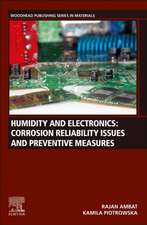Why Things Break: Understanding the World by the Way it Comes Apart
Autor Mark E. Eberharten Limba Engleză Paperback – 24 dec 2004
• It took more than an iceberg to sink the Titanic.
• The Challenger disaster was predicted.
• Unbreakable glass dinnerware had its origin in railroad lanterns.
• A football team cannot lose momentum.
• Mercury thermometers are prohibited on airplanes for a crucial reason.
• Kryptonite bicycle locks are easily broken.
“Things fall apart” is more than a poetic insight—it is a fundamental property of the physical world. Why Things Break explores the fascinating question of what holds things together (for a while), what breaks them apart, and why the answers have a direct bearing on our everyday lives.
When Mark Eberhart was growing up in the 1960s, he learned that splitting an atom leads to a terrible explosion—which prompted him to worry that when he cut into a stick of butter, he would inadvertently unleash a nuclear cataclysm. Years later, as a chemistry professor, he remembered this childhood fear when he began to ponder the fact that we know more about how to split an atom than we do about how a pane of glass breaks.
In Why Things Break, Eberhart leads us on a remarkable and entertaining exploration of all the cracks, clefts, fissures, and faults examined in the field of materials science and the many astonishing discoveries that have been made about everything from the explosion of the space shuttle Challenger to the crashing of your hard drive. Understanding why things break is crucial to modern life on every level, from personal safety to macroeconomics, but as Eberhart reveals here, it is also an area of cutting-edge science that is as provocative as it is illuminating.
“An engaging personal account not just of the physics and chemistry of materials but of the ethics, economics, and politics of innovation, with delightful bonuses on topics from the origins of ‘ghostly’ noises in old houses to the amazing coevolution of armor and armor-piercing projectiles. If it ain’t broke, Mark Eberhart can tell you why—and explain equally well why a shatterproof world remains beyond our reach.”
—Edward Tenner, author of Our Own Devices and Why Things Bite Back
“I don’t remember a book that has taught me so much, nor previously encountering a teacher like the marvelous Mark Eberhart, who in Why Things Break provides enlightening and thoroughly captivating scientific explanations of subjects ranging from the structural failures leading to the sinking of the Titanic to everyday, no-less-fascinating topics such as the reason why, even at the same temperature, winter days always seem so much colder in Boston than in Denver.”—Richard Restak, M.D., author of Mozart’s Brain and The Fighter Pilot
“Eberhart brings his insights to the reader by weaving personal anecdotes—from his childhood fear that cutting a stick of butter would release the energy of the atoms within to his arrival in Boston for an interview with MIT without a suitable winter coat—into a fascinating discussion of the forces that hold atoms and molecules together. A lively, unvarnished look at chemistry on the cutting edge.”
—Kirkus Reviews
Preț: 62.95 lei
Preț vechi: 75.64 lei
-17% Nou
12.05€ • 12.58$ • 9.97£
Carte disponibilă
Livrare economică 14-21 martie
Livrare express 28 februarie-06 martie pentru 31.45 lei
Specificații
ISBN-10: 1400048834
Pagini: 257
Dimensiuni: 134 x 204 x 15 mm
Greutate: 0.21 kg
Editura: Three Rivers Press (CA)
Locul publicării:United States
Notă biografică
MARK E. EBERHART is a professor of chemistry and geochemistry at the Colorado School of Mines. He received his doctorate in materials science from the Massachusetts Institute of Technology.
From the Hardcover edition.
Extras
What incredible luck. The waitress had just unknowingly placed the most amazing water glass on our table. Halfway up the glass was a crack about two centimeters long. This was one of those fantastic cracks where neither end intersected a surface. These are stable and, if left alone, will simply hibernate. Water does not leak from these cracks, their presence is known only by the reflection of light from their surfaces. If disturbed, however, they wake up, sometimes violently, growing with incredible speed, often branching as they go, reducing whatever contained them in their quiescent state to a pile of razor-sharp shards.
Though the crack in this water glass was a rare find, it was even more remarkable in that it was oriented nearly parallel to the bottom of the glass. If gently awakened, the ends of this crack could be made to grow around the glass and meet at the same point, dividing the glass into two parts. Quickly downing the water, I used the handle of a butter knife to tap on the glass, ever so gently, near the tips of the crack. Too sharp a blow and the crack would become uncontrollable. With each tap, the crack grew slightly and stopped. Slowly the ends of the crack worked their way around the glass and, with no apparent sound, they joined. As if by magic, aided only by the butter knife "wand," the glass had been separated.
I was delighted with my carefully divided glass. My lunch companions, however, were less than pleased. I was, after all, with my impressionable young nieces and their parents. The looks on their faces suggested that I had just committed the most ill-conceived of social faux pas. Though this incident occurred nearly ten years ago, the breaking of the water glass is still a subject that causes my nieces and their parents to reflect on my integrity. My "crime" was a minor one. Indeed, the glass would not have survived even one more washing. The thermal strains caused by heating and cooling would have marked the end of the glass's useful life, and such a marvelous crack deserved a more significant death.
My interest in cracks and fracture began in early childhood, when I became fascinated by the idea that it might be possible to prevent things from breaking. I imagined what the world would be like if things never broke. In my child's mind, I pictured both the great and ordinary creations of humankind surviving the ages untouched and pristine. Little did I realize that this simple fantasy would direct my life and open doors I never thought existed.
Perhaps my interest was a by-product of growing up in the 1950s and 1960s. Every child lived with the fear that "the bomb" could be dropped at any minute. In school, it was common for a teacher to open the door of a classroom and yell, "Duck and cover!" In response to this warning, we students were expected to fling ourselves to the floor in a modified fetal position, with hands clasped across the back of the neck. In the absence of the requisite warning, the duck-and-cover position was to be assumed when we saw the blinding flash of an atomic-bomb explosion. I firmly believed that the duck-and-cover position would protect me from an atomic blast, but I knew the inanimate part of the world would surely be destroyed. After all, the purpose of duck-and-cover was to protect us from the flying pieces of objects broken by the blast. This seemed to be such an incredible waste. How could people work so hard to build things, only to see them destroyed? To me, making things that didn't break was one way around the destruction that nuclear war would bring.
The fear of pending nuclear annihilation may have seeded my interest in combating fracture, but the same fear also directed me down a path that would ultimately provide the tools necessary to achieve that goal. An axiom of the time was that "the power of the atomic bomb was unleashed by splitting the atom." This concerned me. If splitting a single atom were to cause an atomic explosion, was it possible that someone might inadvertently slice through one while using a knife or a pair of scissors? I pictured little mushroom clouds over thousands of dinner tables, each the result of an accident with a butter knife, but this never happened. Fortunately, the expected news story--"Today the John and Betty Smith family, their home, and the surrounding neighborhoods were demolished as John attempted to butter his bread"--never made the six-o'clock news. The only explanation for the absence of unintended nuclear blasts was that a butter knife was incapable of slicing through an atom. As a six-year-old, I began to construct a model that would explain this observation.
I envisioned the atoms of the butter as marbles spread out on the floor so that they just touched. Because everything was made from atoms, the edge of a knife could also be pictured as marbles, perhaps marbles of different sizes, peewees or boulders, but still marbles. The act of cutting the butter was like dragging the "knife" marbles through the other marbles on the floor. In my mind's eye, I picture holding a marble and pulling it through the marbles representing the butter. The knife would separate the marbles into two groups, but never would another marble be cut in half.
Though I slept easier knowing that making breakfast was unlikely to trigger Armageddon, a new question began to preoccupy me. There had to be something that held atoms together. If atoms were like marbles, they would just puddle out when taken out of their container. The knife was cutting not the marbles themselves, but whatever it was that held the atoms together.
I can't remember actually performing the marble experiment, and I doubt that I ever did; I valued my marbles too much to actually use them. Those of my friends who actually played the game had the most pitted and ugly marbles you could imagine. With only a few exceptions, my marbles remained as perfect as the day they were purchased. To me, a chipped one was worthless, having lost its value with its beauty. The exceptions were those marbles that were intentionally fractured to make them even more beautiful. The procedure is simple. Place a marble (a "cleary" is best; that's a marble made from a single piece of colored class, devoid of internal decoration) on a cookie sheet and heat in an oven to 250¡ F. Remove the marble when heated, and immediately drop it into cold water. Under these conditions, most marbles will respond by producing an array of internal fractures. The reflection of light from these internal surfaces produces an esthetically pleasing effect.
The problem with such marbles is that almost any blow will cause the cracks to run, leaving you with a pile of broken glass. They are useless from a utilitarian viewpoint; they can't even be carried in a marble bag for fear of shattering them. So, though I had come up with a method to preserve, and even extend, the beauty of my marbles, it was not a practical solution, since it required that they not be used. There had to be another way. Was it possible to make a glass marble that would not pit when used?
Having already developed an idea about what happens when something is cut, it took only a tiny step to picture what happened when something broke. Once again, I pictured the atoms of the glass as marbles packed together on the floor. This time a marble was shot at the pile, just as in the real game, dislodging other marbles from the central group. These dislodged marbles I thought of as the atoms of the broken chips of glass. If one wanted to make glass that would not chip, then whatever held the atoms of the glass together must be made stronger.
I still had no idea what held those atoms together. I had several small magnets, however, and I imagined the force holding the magnets together had to be similar to that holding atoms together. The problem with magnets, however, is their shape. Mine were horseshoe magnets and didn't look much like spherical atoms. Despite all my efforts, I could not seem to locate magnetic marbles. It appeared that my very first scientific investigation had come to a grinding halt at the ripe old age of six. Three years would pass before it could be revived.
In third-grade science class, we were observing magnetic fields by placing a sheet of paper over a magnet and then sprinkling iron filings on the paper. The purpose of the experiment was to observe how the filings lined up in the magnetic field. It was neat that something invisible could be made visible so easily. Even neater, however, was the fact that the iron filings became magnetic and attracted each other. Would little iron marbles behave the same way?
At the hardware store, they told me little iron marbles were called ball bearings and they came in many sizes. With my birthday money, I bought about a hundred BB-sized ball bearings and two bar magnets. At home, I set the bar magnets on end underneath a piece of cardboard and then poured the ball bearings on top. It worked exactly as it was supposed to; the ball bearings became magnetic and attracted each other. By gently tapping the cardboard, the bearings would arrange themselves in a periodic array. If the two magnets were set sufficiently far apart, two arrays could be made. Then, by dragging the magnets underneath the cardboard, the groups of bearings came together to form a single island. Depending on how the magnets were arranged (the north end up on one and the south end up on the other, or both magnets with the same end up), different results were obtained. Sometimes the groups of bearings would form a single array in which it was impossible to distinguish to which group a ball bearing originally belonged, and sometimes they would coalesce into a single group of bearings with an odd line that marked the boundary between the two. If the cardboard was gently vibrated, the boundary would disappear. By reversing the process, the island could be made to fall apart in two pieces. The boundary between the two islands of bearings looked different depending on how fast the magnets were pulled apart.
I played with my magnets and ball bearings for hours and discovered that by changing the strength of the magnet, the forces holding the ball bearings together could also be changed. This was accomplished by simply moving the magnet farther away from the cardboard. I made little spacers that fit between the magnet and the cardboard for this purpose. The larger the spacer, the weaker the bond. Using a strong magnet with no spacer, I would shape little wedges of ball bearings and ram them into the flat surfaces of oblong shapes, held together with a magnet separated from the cardboard by a large spacer. The oblong shape would deform and remain deformed when the wedge was withdrawn. On occasion, some of the bearings of the oblong were pulled away by the wedge.
After all the play, I was convinced that the different behaviors of ball-bearing atoms resulted from the strength of the forces that held them together. But I still did not know what held real atoms together. I was determined to find out.
Seven years later, in a high school chemistry class, I finally had my answer. They were chemical bonds. It turned out that the science of chemistry was concerned almost entirely with the study of these bonds--moving them, strengthening them, and so on. If you wanted to do something to a bond, you had to be a chemist, and that is exactly what I intended to become.
Though I now knew the things holding atoms together were called chemical bonds, actually understanding how those bonds worked would require considerable effort. Unlike baseballs, cars, and magnets, which respond to force according to the laws discovered by Newton, bonds respond in a very different way. So different and strange is their response that it was not until 1926 that the laws governing their behavior were discovered. Things that behave according to the laws of Newton are said to behave classically and obey the laws of classical mechanics. Bonds, however, obey the laws of quantum mechanics.
From the perspective of a high school student, the laws of quantum mechanics appear to make no sense. For example, those laws allow something to be in two places at the same time. Though this violates common sense, common sense is based on experience, and our experience is consistent with the laws of classical mechanics. Understanding quantum mechanics requires everyday experience to be set aside, and in its place one substitutes the mathematical expressions describing the new laws discovered in 1926 by Erwin Schrsdinger. Unfortunately, as a high school student I did not have the mathematical maturity necessary to understand quantum mechanics.
The desire to have my marbles and use them too had made the agenda clear. Study chemistry and learn how to manipulate bonds, study mathematics to understand quantum mechanics, and study quantum mechanics and learn how bonds worked. I elected to pursue this agenda at the University of Colorado in Boulder.
A student living in Boulder is faced with a number of distractions. Boulder is located at the base of the Rocky Mountains. Some of the most spectacular rock climbing in the world can be found just a few minutes from campus. A little longer drive away is world-class skiing. Of course, the ski season begins in December and generally ends in April, requiring skiers to find some other activity for the summer months. Whitewater kayaking was my summer activity. Chemistry and mathematics classes, skiing in the winter and spring, kayaking in the summer and fall, left little time to do much else, like get a job. Little did I suspect that my life as an unemployed student ski-and-kayak bum would transform me into a real expert on why things break.
As I studied chemistry, I constantly anticipated that the answer to why things broke was just around the corner. With the beginning of each semester came the same ritual. I would search through my newly purchased textbooks looking for some reference to fracture, some explanation. There were literally full chapters discussing the techniques for manipulating chemical bonds and transforming one molecule into another, but nothing about why those bonds unsurprisingly broke. The study of quantum mechanics was more involved with the interaction of molecules and solids with light than with mechanical forces. Though I never found a complete answer to my question, a good deal of what I learned seemed relevant to the problem of fracture. I filed this basic information away while I waited for the whole puzzle to come together.
From the Hardcover edition.
Descriere
Did you know—
• It took more than an iceberg to sink the Titanic.
• The Challenger disaster was predicted.
• Unbreakable glass dinnerware had its origin in railroad lanterns.
• A football team cannot lose momentum.
• Mercury thermometers are prohibited on airplanes for a crucial reason.
• Kryptonite bicycle locks are easily broken.
“Things fall apart” is more than a poetic insight—it is a fundamental property of the physical world. Why Things Break explores the fascinating question of what holds things together (for a while), what breaks them apart, and why the answers have a direct bearing on our everyday lives.
When Mark Eberhart was growing up in the 1960s, he learned that splitting an atom leads to a terrible explosion—which prompted him to worry that when he cut into a stick of butter, he would inadvertently unleash a nuclear cataclysm. Years later, as a chemistry professor, he remembered this childhood fear when he began to ponder the fact that we know more about how to split an atom than we do about how a pane of glass breaks.
In Why Things Break, Eberhart leads us on a remarkable and entertaining exploration of all the cracks, clefts, fissures, and faults examined in the field of materials science and the many astonishing discoveries that have been made about everything from the explosion of the space shuttle Challenger to the crashing of your hard drive. Understanding why things break is crucial to modern life on every level, from personal safety to macroeconomics, but as Eberhart reveals here, it is also an area of cutting-edge science that is as provocative as it is illuminating.
“An engaging personal account not just of the physics and chemistry of materials but of the ethics, economics, and politics of innovation, with delightful bonuses on topics from the origins of ‘ghostly’ noises in old houses to the amazing coevolution of armor and armor-piercing projectiles. If it ain’t broke, Mark Eberhart can tell you why—and explain equally well why a shatterproof world remains beyond our reach.”
—Edward Tenner, author of Our Own Devices and Why Things Bite Back
“I don’t remember a book that has taught me so much, nor previously encountering a teacher like the marvelous Mark Eberhart, who in Why Things Break provides enlightening and thoroughly captivating scientific explanations of subjects ranging from the structural failures leading to the sinking of the Titanic to everyday, no-less-fascinating topics such as the reason why, even at the same temperature, winter days always seem so much colder in Boston than in Denver.”—Richard Restak, M.D., author of Mozart’s Brain and The Fighter Pilot
“Eberhart brings his insights to the reader by weaving personal anecdotes—from his childhood fear that cutting a stick of butter would release the energy of the atoms within to his arrival in Boston for an interview with MIT without a suitable winter coat—into a fascinating discussion of the forces that hold atoms and molecules together. A lively, unvarnished look at chemistry on the cutting edge.”
—Kirkus Reviews





























